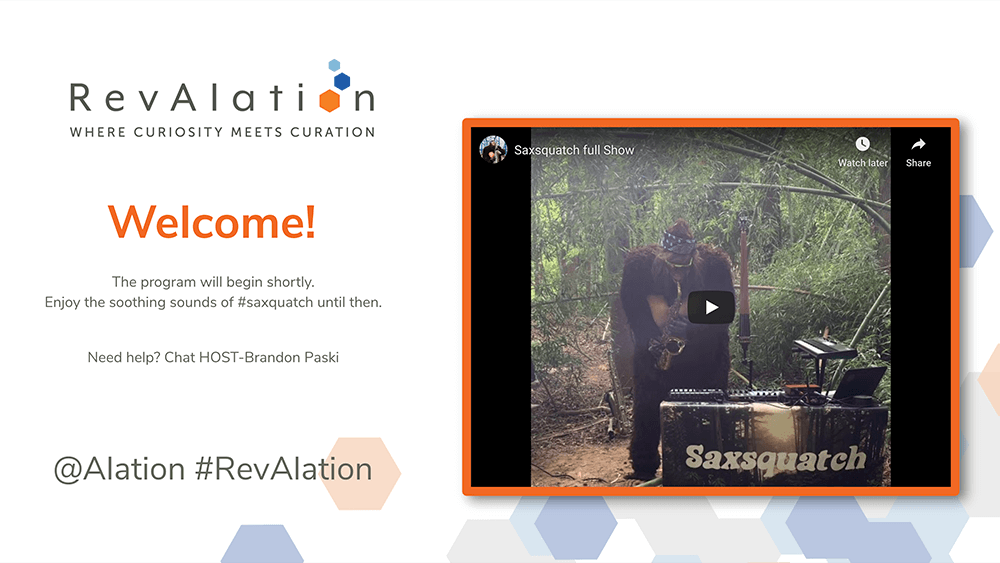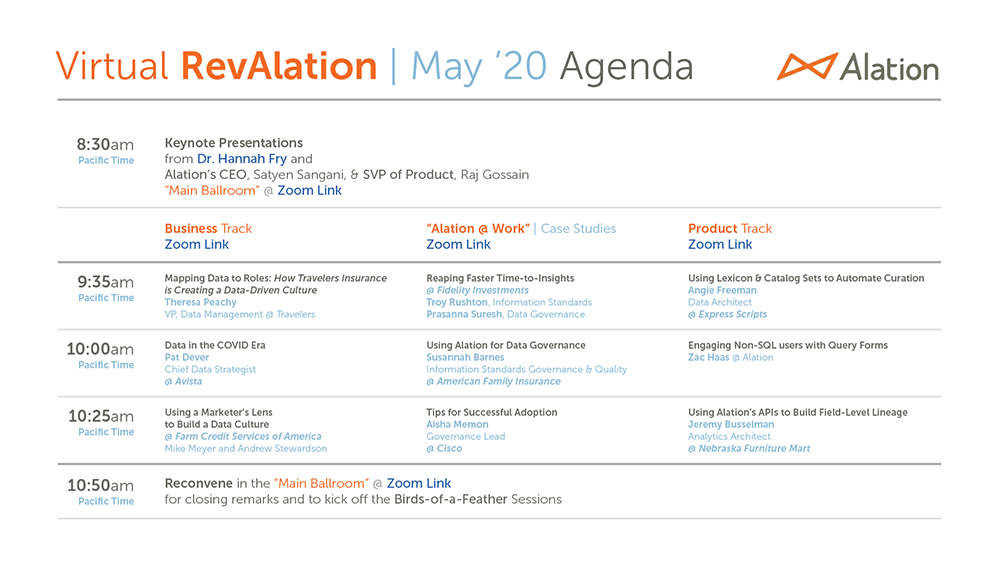
YouTube performer Saxsquatch was the first thing RevAlation attendees saw while waiting for the event to begin. (Courtesy RevAlation)
In early April, when the COVID-19 pandemic was forcing organizations to cancel their face-to-face events or move them online, David Stevens, director of global events for the Redwood City, California–based tech firm Alation, saw an unexpected opportunity: They had been planning to present their first large, face-to-face user conference in 2021; now they could do a test-run for the planned face-to-face event online.

David Stevens
Before 2020, Alation did 12 regional “roadshow” events for customers in the course of about 18 months, Stevens told Convene. The events, held across the United States and in Europe, each attracted between 50 and 100 people. But the enterprise data catalog company wanted to move to “a more centralized approach” and bring together a larger group of customers all at once for a bigger conference to be called RevAlation. They planned to ease up on the regional meetings in 2021, he said, to “let demand build” for a larger event.
Instead, they decided to move to an online event sooner, “because everyone was clamoring to get together,” Stevens said. “We were about six weeks into the pandemic and our customers were just craving online connectivity. They wanted to see each other and talk to each other.”
On April 20, the firm moved forward with a plan to create Virtual RevAlation and set its date for May 28. Registration launched on April 26, with an expectation that the complimentary event would draw possibly 200 to 300 people, “with a stretch goal of 500,” Stevens said. The event ended up attracting 861 registrants and 604 attendees.
Stevens and his team had 38 days to create and pull off a successful event that would engage attendees where they live and replicate the kind of human connections established at live events — and moreover, make them eager to return for what will likely be a hybrid RevAlation in 2021.
Stevens wanted the virtual event to feel like a live conference, not just with strong sessions but entertaining moments. He had stumbled across “one of the best internet gems I’ve seen in a long time” in the Saxsquatch YouTube channel. The channel contains several videos of a person dressed as a Bigfoot-like creature, or sasquatch, playing familiar songs on a saxophone in the woods.
Alation sent attendees an email 24 hours before the event began that included a link and password to the general session room on Zoom, the platform Stevens chose because of the Alation team’s familiarity with it. “Trying to learn how to use a new tool … going into a now 600-person event made no sense,” he said. They used Zoom Meeting and received training on unfamiliar features.
When attendees entered the room, they found one of the Saxsquatch videos embedded into the welcome slide. The idea was to emulate a general session room at a live event, where music usually is playing and lights are flashing as the audience takes their seats. The Saxsquatch surprise, Stevens said, helped set the tone for the rest of the half-day event.
“It immediately engaged everyone. Our chat room moderator contacted me and said ‘Chat is blowing up. People are loving this,’” said Stevens, who hopes to get the musician to perform live at future events. Attendees, he said, immediately understood that “this is a different kind of conference.”

Alation sent attendees Virtual RevAlation attendees an agenda PDF that had Zoom links to various rooms to make it easy for them to move around the virtual conference. (Courtesy Alation)
Attendees then were sent a downloadable PDF with the entire half-day agenda. It included clickable Zoom links to the various rooms where programs would take place.
- The “main ballroom” was used for the opening keynotes, each just 10 minutes long, from Alation CEO Satyen Sangani, SVP of Product Raj Gossain, and mathematician/author Hannah Fry.
- Nine customer-led sessions took place in three other rooms, each aligning with a session track: case studies, business, and products. Each session lasted 15 minutes, with an added five-minute Q&A period.
- Later, eight more Zoom rooms served as breakout rooms for Birds-of-a-Feather sessions, each designed to facilitate a roundtable-style, peer-to-peer discussion about a specific customer-focused topic.
The agenda PDF and links allowed attendees to enter a session and if they decided it wasn’t for them, to simply click another link and enter a different session — just as they would go from space to space at a live event. After each session, slides would appear to remind everyone of what was next.
Alation placed monitors in every room, which also were equipped with Sli.do — another tool familiar to its employees — to promote more interactivity from attendees through questions, polling, and other activities. The entire internal team kept in touch via Slack, which served as the show-running app so that all sessions stopped and started at the same time.
Just to make sure things ran smoothly, Stevens’s team set up waiting rooms in Zoom so that speakers and moderators could enter the session rooms first to ensure all their equipment worked properly before opening the doors to attendees. With any kind of delays, Zoom allows users to message attendees in the waiting room to let them know things would begin shortly — another aspect of live meetings that planners have to anticipate.
Of all the planned similarities to a live meeting built into Virtual RevAlation, the “most human element” of the entire event occurred at the end, as the Birds-of-a-Feather sessions concluded. Although it wasn’t required, many attendees returned to the main ballroom where some Alation team members awaited them.
“We got to talk to them and ask, ‘Hey, how was your Bird of a Feather?’” Stevens said, likening it to the “informal chit-chat you have while hanging out in the lobby of any live event. You’re just making a connection.”
Reactions from attendees during that “really fun, lobby-level close” were positive, Stevens said, and answers from their post-event survey backed up that response. Alation received an overall 4.7 rating from attendees who were asked to rate, on a scale of one to five, how interested they are in attending another RevAlation. He said 95 percent of respondents said they learned something that will help them do their job, while between 80 to 85 percent said they wanted to attend another one in six months.
“One of our company’s core values is to measure through customer impact. We saw that in our survey results,” he said. “You can’t ask for better numbers than that.”
Key Takeaways from Planning Virtual RevAlation
Dave Stevens shared some of the main lessons he learned planned the Alation event that all planners should keep in mind.
Audience Comes First
Steven knew that even before attendees could be wowed by Saxsquatch, they had to be okay with the time they were asked to tune in to Virtual RevAlation. With that in mind, he considered the time least troublesome for the company’s audience, landing on 8:30 a.m. California time, which wasn’t too early for the West Coast, or too late for European customers.
Another consideration was how much time attendees would be willing to spend online. “One of the big things we really took to heart is best practices … when it comes to attention span,” Stevens said. “You can’t have a 45-minute or 60-minute keynote. We didn’t have a single session that went more than 20 or 25 minutes. We kept it moving.”
Practice Makes (Almost) Perfect
Stevens said he likely annoyed many of his team members with his desire for multiple rehearsals. Alation conducted tech checks both on site and with remote speakers. The company sent speakers mailings containing mics, headsets, and other useful gear. And the night before, everyone took part in a full dress rehearsal. “Rehearsals are critical,” he said.
Figure It Out as You Go Along
Finally, planning and completing a virtual event can be “really scary,” but it isn’t close to impossible. “This was much easier than I expected it to be,” Steven said, admitting that Alation’s event wasn’t large. “We didn’t have sponsors; it was just content. It was just us engaging our customers. But for people who are worried about going from a live event to a digital one, I say just go for it, you’ll figure it out.”
Curt Wagner is an associate editor at Convene.
